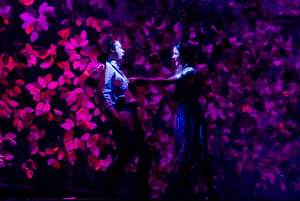Stepping out of the comfort zone
Dee Evans explains the benefits and challenges of ‘full-on’ international co-productions

We have two main reasons for doing this work: bringing international artists and work to our audiences; and gaining professional development for our artists and staff. Fulfilling the first, we have presented three main stage productions; ‘Romeo and Juliet’ our co-production with Salida Theatre using artists from the UK, Colombia, France and Spain, and The Astillero Tango Orchestra from Argentina in the spring of 2010; ‘Hamlet’ by the National Drama Theater of Skopje from Macedonia in autumn 2010; and ‘Captain Corelli’s Mandolin’ in a co-production with the Marjanishvilli Theatre, Tbilisi, Georgia this autumn. Interestingly, the two full-on international co-productions – ‘Romeo and Juliet’ and ‘Captain Corelli’s Mandolin’ – are among the fastest and highest selling shows we’ve produced in the 14 years that I have been at the Mercury Theatre. ‘No surprise’ you may say about ‘Romeo & Juliet’, but who would have thought that watching almost 40 puppets performing side by side with 5 actors from Britain and Georgia would be such a hit for Colchester?
Fulfilling the second reason, and to deepen the experience (or just to stretch ourselves that little bit further) we also created three short pieces with artists from our five artistic partners in the PLOTS (Places, Links, Opportunities, Transitions, Stories) project and successfully performed in Colchester (UK), Pazardjik (Bulgaria), Legnica (Poland), Lecce (Italy) and Skopje (Macedonia) in five small theatre festivals. We wanted to create a depth of collaboration that’s far greater than simply buying each other’s work. This was about working together, exploring different approaches to work and learning from each other: the only way to do that is to start working and creating together, getting our hands dirty. So we did that too.
It hasn’t been so much like Piccadilly Circus at the Mercury – more like UK Border Control with ‘welcome one and all’ as our slogan.
So, what have we learnt through these collaborations? Well, check, check and check again that everyone is agreeing to the same thing. Sometimes we believed we were in agreement and yet it wasn’t really the case – perhaps because of language barriers or because of assumptions about one another and the way we work. Also, dates seemed to be more flexible for other venues that don’t programme around their own work like the Mercury. This created difficulties for our staff who are used to working to earlier deadlines, publishing brochures and putting shows on sale much earlier than our partners.
To make working together as easy as possible we held three preparatory workshops for artistic, administration and technical technical staff. These were brilliant preparation for the experience of working together across borders. However, we realise now that we would have benefitted from adding a marketing workshop to the programme as there were major differences in approach from country to country and our requirement for actors’ biographies and digital material came as a surprise to those countries that don’t print programmes or brochures to promote their work.
But these are small things. A key legacy of our international project is the creation of a group of partners who are a resource to draw upon for future international collaboration. The project has enhanced our ability to plan and manage work across the world and helped us to become an experienced resource for other partners who want to work with us. We know about visas, shipping, transport, accommodation, per diems… not to mention Google Translate. You name it, we’ve tackled it.
Gina Isaac, one of the actors, sums up the experience from an artist’s perspective: “We all had to be flexible and open to each other’s needs and limitations. As much as this was frustrating at times it really opened up an honest dialogue in rehearsals. This was very refreshing and ultimately allowed some very creative ideas to appear. Also, because there was such a mix of languages in the room, you absolutely had to be clear about what you felt and wanted to say. It was great to be able to be very direct with people – it was good for the work. I was very aware of the cultural differences between my PLOTS colleagues. This surprised me, as before I started this project I thought I would be looking for the similarities. But our diversity is what is interesting. That’s where you find the really good stuff. I found myself appreciating these differences every day and enjoying them.”
So, international collaboration might not be the easiest option, but it is certainly an enriching and challenging experience. It takes audiences, artists and staff out of their comfort zone and brings people together at a deeper level – I wholly recommend it. And we’ll be continuing our adventures in Mumbai with an Indian co-production and youth programme in 2012. Watch this space…
Join the Discussion
You must be logged in to post a comment.